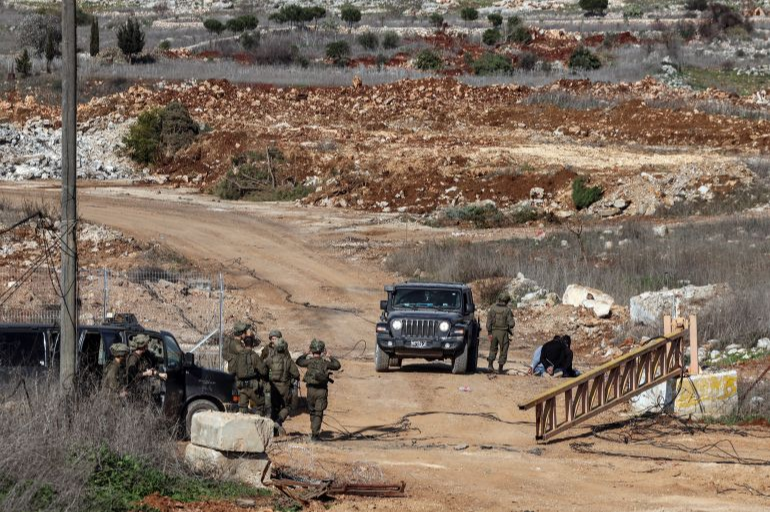
Israeli military expected to remain at strategic locations despite ceasefire condition of retreat by February 18th.
Israeli soldiers stand near Lebanese detainees at the Israeli-Lebanese border, as seen from northern Israel, after a ceasefire between Israel and Hezbollah took effect, January 27, 2025. REUTERS/Ronen Zvulun
Beirut, February 17 (RHC)-- Lebanon is warily eyeing the actions of the Israeli military as the deadline for the withdrawal of its troops from the south of the country approaches. The government in Beirut expressed concern on Monday that Israel will not move all of its forces out of Lebanon by the agreed deadline of Tuesday, February 18th.
“We are afraid that a complete withdrawal will not be achieved tomorrow,” Lebanon’s President Joseph Aoun said, according to his office.
An Israeli official told The Associated Press news agency that the military will continue to occupy five strategic points on Lebanese soil. The report did not specify the exact location of those five sites.
Lebanon’s concerns about the Israeli army’s plans illustrate the fragility of the ceasefire between Israel and Lebanese group Hezbollah. They also come amid several reports of attacks across Lebanon – a common tactic of the Israeli military on the eve of a cessation of hostilities.
A drone struck a car in the port city of Sidon, the deepest of Israel’s many attacks in Lebanon since the ceasefire agreement took effect in late November. The strike, near a Lebanese army checkpoint, killed a Hamas official who headed the group’s operations department in Lebanon, the Israeli military said.
Al Jazeera’s Zeina Khodr, reporting from the scene, said that “Israel acts with little restraint.”
A drone also dropped a grenade on the main square of the southern town of Kfarchouba, while setting fire to houses in the border town of Odaisseh, according to Lebanon’s National News Agency.
Ramzi Kaiss from Human Rights Watch said “Israel’s deliberate demolition of civilian homes and infrastructure” was making it “impossible for many residents to return” home.
Partial withdrawal?
Israel and Hezbollah agreed to the ceasefire – which has been in effect since November 27 – to bring an end to months of all-out war, during which Israel launched ground operations against Lebanon and assassinated a wave of top Hezbollah figures, including chief Hassan Nasrallah.
Under the deal, the Israeli army was to withdraw from southern Lebanon over a 60-day period, while Lebanon’s military was to deploy in the Hezbollah heartland alongside United Nations peacekeepers.
The deadline, which fell in late January, was later extended to February 18.
Hezbollah, meanwhile, was to pull back north of the Litani River – about 30km (20 miles) from the border – and dismantle any of its remaining military infrastructure in the south.
However, last week, Israel accused the Lebanese armed group of failing to abide by the deal, and said it did not plan to fully withdraw in the short term, but would instead leave troops in five key locations.
Lebanon’s parliamentary speaker Nabih Berri, a Hezbollah ally, said he had received word from Washington that Israel would remain in those five locations, a plan Lebanon rejected.
“What we’re hearing from Lebanese officials is that Israel will withdraw from some villages, but will remain in strategic locations on hilltops just a few metres inside Lebanon,” reported Al Jazeera’s Khodr.
It is assumed that the positions Israel intends to maintain will offer military control across southern Lebanon.
Karim Bitar, lecturer in Middle East studies at the Paris Institute of Political Studies (Sciences Po), said, “It appears that there is a tacit if not an explicit U.S. agreement to extend the withdrawal period.”

